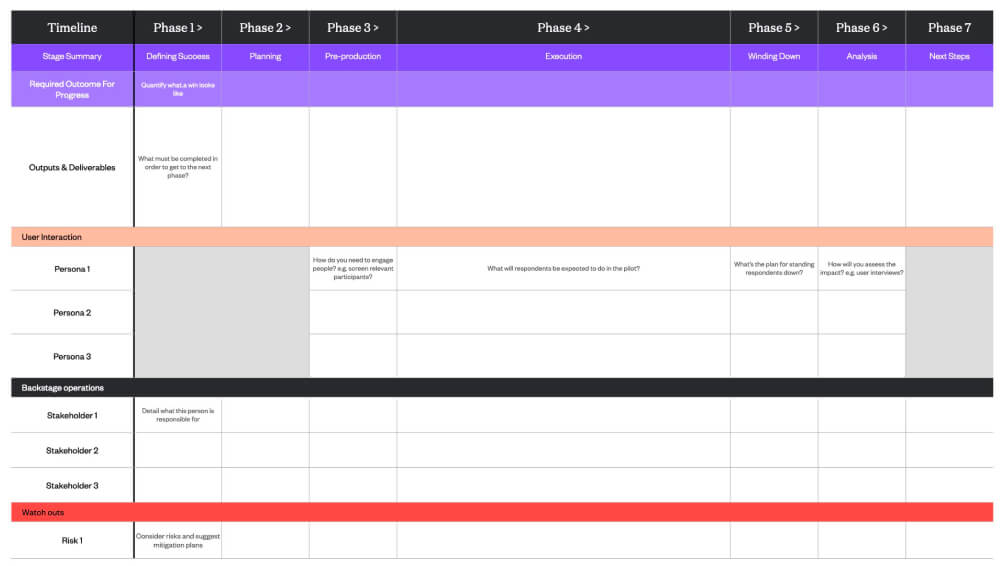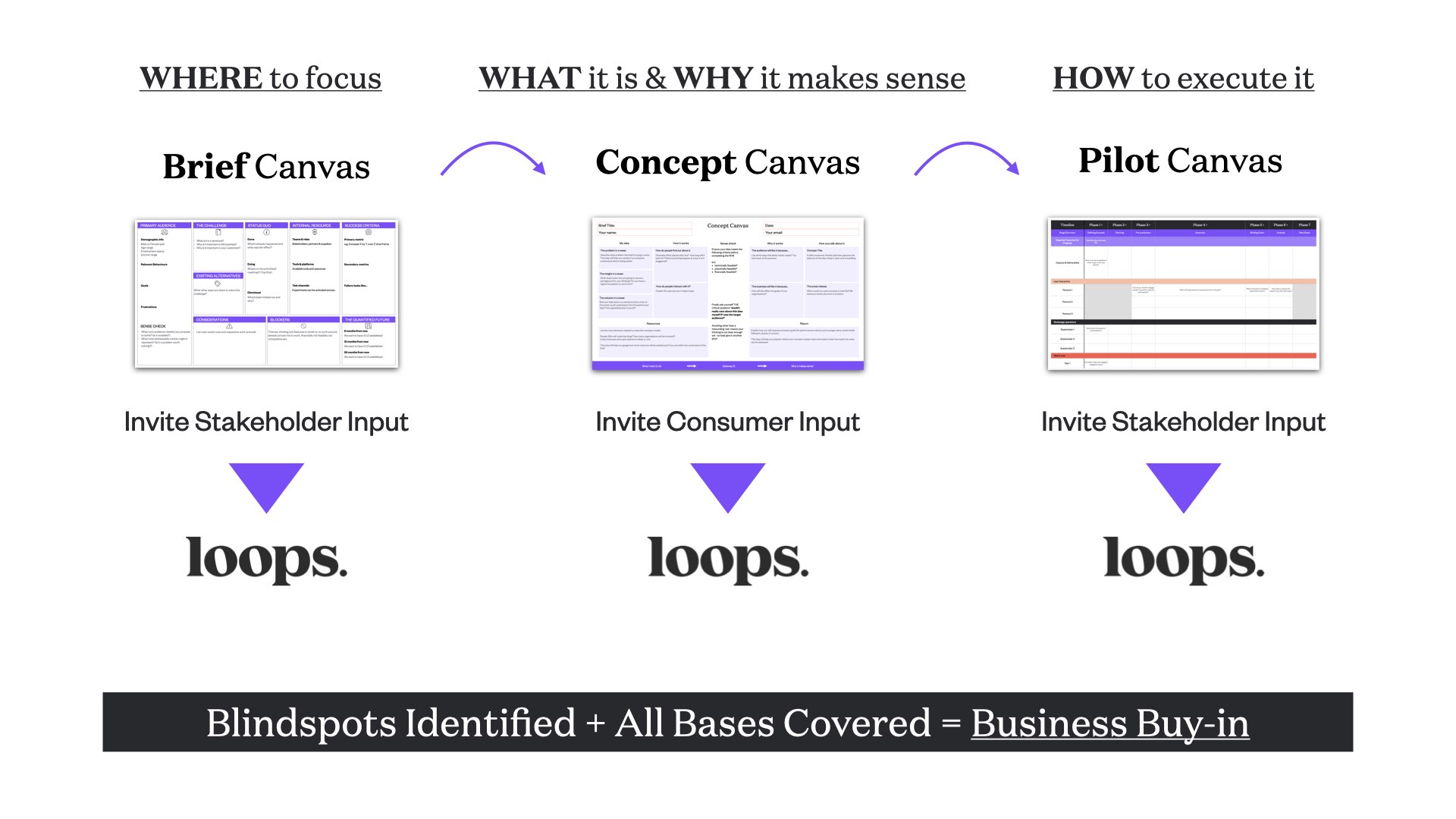This article is part of a blog series focused on how to introduce, explain, and condense complex thinking into a single-page view so that other people can easily understand you.
Defining what a Pilot Project/Pilot Study/Pilot Experiment is
Understanding the meaning of 'pilot project' is key - the idea is essentially a small-scale trial run conducted before launching a committed project, to evaluate feasibility, time, cost, user feedback and identify areas of potential problems before full implementation of the project.
A pilot project enables project managers to gather valuable feedback, assess viability and identify resources needed before making significant investments. They provide relevant data and valuable insights to inform decision making and resource allocation for the full-scale implementation from stakeholders and project management.
By conducting a pilot study, you can test your idea on a smaller scale, gather quantitative and qualitative data, and use the lessons learned to create a more accurate budget and project plan for the full project. A well-run pilot study is the ultimate way for a project manager to confirm viability and that everything will run smoothly before committing more resources.

Starting A Successful Pilot Project
This is the final piece in our Loops Canvas range - the Pilot Canvas.
By now, you've written a solid brief and defined a relevant concept. Now it's time to make it real by delivering a prototype and assessing if true business potential for the new idea exists. A clear pilot project plan will help massively when your new project is in ‘live' mode, as it will focus your brainpower on learning and the process as a whole, as opposed to reacting on the fly.
What Is The Pilot Canvas?
The Pilot Canvas splits your pilot projects into six major, easy-to-digest sections. This offers companies the scope to implement more insightful business practises from the get go, keeping customers and their own interests at the centre of the planning process. It's an invaluable tool for project management, helping you clarify objectives, identify relevant resources, and plan the entire process ahead of a full-scale project.

Why We Created The Pilot Canvas
Our Pilot Canvas can be a valuable asset during the testing process to any company running pilot projects. This one-page tool allows you to define each stage of your pilot project from early planning to final wrap up and analysis, and it can be applied across large and small scale pilot projects. You no longer need to search for the answers to stakeholders' questions when you've got them on a single sheet right in front of you.
Breaking down each phase of your pilot project and considering all the resources required to deliver it over time and on time is critical. Think of it like writing a film script, detailing each scene and explaining the actors' objectives to deliver the required outcome and accomplish the shared business goal/vision. By ensuring a shared vision throughout your pilot project, and ensuring your whole team is in onboard, you're then on the path to success.
Using our Pilot Canvas to successfully manage and carry out your pilot projects will simply smooth over the whole project management process in the long run. It is also a good habit to form when it comes to longer term or multi-company pilot projects that could easily leave a team scrambling.
Creating a successful pilot program can be a lengthy process, but the effort is worth it. Having a detailed plan with all the key steps laid out within your team can help meet the set clear objectives - who, what, when, why - and avoid failure.
The Pilot Canvas Builds A Pilot Project Timeline Across Six Levels:
- Stage Summary
- Required Outcome For Progress
- Outputs & Deliverables
- User Interactions
- Backstage Operations
- Watch-outs
Here are our tips for the type of details about your pilot project you should be including in each of the Pilot Canvas' boxes:
Stage Summary
This is what it says on the tin. We've given you the basic stages, from start to finish, of how to run a pilot project, but you should always assess the situation and modify these to suit your needs.
Our example steps for a pilot project are as follows:
- Defining success
- Planning
- Pre-production
- Execution
- Winding down
- Analysis
- Next steps
Required Outcome For Progress
Defining the validation event means identifying the point at when the work is finished, ideally with a successful outcome, meaning you can then move to the next stage. Try to quantify the results and be as specific as possible - the more specific you are, the more insight you can gather and the more easily you can evaluate your plan in the future.
A simple example for the pre-production stage could be '300 downloads of the prototype via Testflight'.
Qualitative or quantitive data - both are extremely valuable.
Outputs & Deliverables
List out all the tasks and requirements you need to complete before you can move onto the next stage of implementation of your pilot project.
For example. before you move onto the ‘Defining Success' stage, you may need to do some desk research to see if you can obtain any data or insights on successful outcomes of similar products to understand what ‘good' looks like. Case studies and surveys are great resources for this kind of evaluation.
Or, if you're moving onto the ‘Winding Down' stage, you may need to arrange time to interview pilot participants for them to share feedback, or to hold group discussions. This qualitative feedback will be vital for avoiding failure, identifying areas for improvement for informed decisions to help with future projects.
The Benefits Of User Interaction
Complete this section only when participants are actively involved in a stage of the pilot project.
You want to list every likely touch point you'll have with them and what they're expected to do. Here, you really need to put yourself in the user's shoes and imagine all the steps they'll take. This is where you usually uncover blindspots you'd not previously considered, such as signing NDAs or how you're going to pay respondents.
Not doing these self evaluations will waste time later on, and doing so now could open a door to a potential new solution.

Determine Your Team
Now you are clear on the outputs of feasibility study and what participants are expected to do, you can decide who in your team will own each part of the pilot project and what they must contribute to each phase. It's important to remember each team member's strengths and weaknesses - they may influence the outcome of your pilot project.
You may need to provide training for your team where appropriate, but that shouldn't be a major concern. If anything, that should be seen as a benefit in the long term.
This assignment is one of the most useful tracks of info since each of the key stakeholders can quickly zoom into their job on the Pilot Canvas and see how it ladders up to the pilot project as a whole.
Effective resource allocation is critical for the success of any project, and trial implementations/pilot studies are no exception. By clearly defining roles and responsibilities upfront, and providing team members with the training and tools they need to succeed, you set the stage for a well-executed project trial. The Pilot Canvas serves as a centralized resource that keeps everyone informed and aligned, no matter their individual focus.

Implementing Risk Management
If you feel there are risks in your pilot project (which there will inevitably be), call them out. If you can, suggest a mitigation plan in case they come to pass, and run a trial if possible.
Whilst it can be mentally draining thinking through all these trial scenarios, you will be glad that you did because you'll gain business insight and uncover any flaws in the project. Your task is to apply the missing information so the end-to-end logic holds up and is supported by the data.
In doing so, you'll minimize risk, be able to respond quickly, and not fall behind schedule. Watch out for those curveballs, though!
Simplicity And Insight Are Key For A Successful Pilot Program
As with each of the tools we've given away, you can create a free account at useloops.com/register, upload your completed Pilot Canvas, and then share via a link to the relevant people for instant visual feedback on your pilot project.
With this new technology, you'll unlock their business expertise to help you unearth blindspots in your project and find improvements. You also get a one-up on other companies in terms of how to run a pilot project. On the one hand, you'll align them to the mission, and on the other, you'll gather feedback and refine the plan. All this means your project will make faster progress while also increasing the likelihood of success.
Download all the canvases in editable Keynote format.

